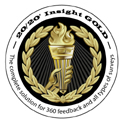Research evidence supports the conclusion that the most effective people are those who know themselves, recognize the demands of the situation, and adapt strategies to meet those needs. You have taken the first step in knowing yourself by completing the DiSC® Profile and receiving your report. With this information you will be able to:
- identify your behavioral profile
- capitalize on your behavioral strengths
- increase your appreciation of different profiles
- anticipate and minimize potential conflicts with others
Here are a few suggestions on how to use your report:
- Behavioral Highlights – check off all of the statements you agree with on this page. The DiSC® Profile uses the concept of face validity. This indicates the level to which the respondent agrees with the data. The greater the number of statements you agree with on this page, the greater the likelihood the rest of the report will provide valid information. If, for some reason, you agree with less than 80% of the statements, we recommend you complete the DiSC® Profile again at a later time with additional guidance.
- DiSC® Profile Graph – the higher the plotting point in any of the four dimensions of behavior, the more likely you will be to use that behavior. Conversely, the lower the plotting point the least likely you will be to use that behavior. Most people seem to have a strong combination of two of the dimensions. Review the four dimensions to get a feel for the DiSC® model and how it relates to your behavior. Listen to a short introduction on this web site.
- Behavioral Overview – this narrative description of your behavioral tendencies provides a view of your overall behavioral pattern based on the interaction of the four DiSC® Profile dimensions. As you read this, highlight or underline the statements you agree with the most. Cross out statements you disagree with. Add additional comments about your behavior that come to mind as you read through the report.
- Motivating Factors/Preferred Environment – each of these reports will help you look at your environment from a behavioral perspective. After checking off the statements you agree with, go back and place another checkmark next to these statements if the condition or attribute exists in your present environment. The more double checks you have the greater the likelihood of experiencing high motivation in that environment. If there are few double checks you might engage in discussions with team members and your team leader to see how the environment can be changed to better meet your behavioral needs.
- Tends to Avoid – you probably already know these things about yourself, but have you communicated them to others? After checking off the items that are true for you, discuss them with people who count on you for results. Sometimes you will find an opportunity to swap a task you dislike with another team member who is more motivated to engage in that task. If that is not possible, look for ways others can support and encourage you.
- Strategies for Increased Effectiveness – if you are already effective in your environment you are probably using some of these suggestions. If you find a new idea, be intentional about implementing it over the next 30 days and see what happens. Seek a mentor to review this list with you.
- Demotivating Factors – sometimes we can find more energy quicker by removing a demotivator than by trying to add motivators in our environment. Once identifying these demotivators, again discuss them with your team and see what ideas you can come up with to make the necessary changes.
- Behavior in Conflict Situation – find a partner you trust and review this list together following the instructions in the heading of the report. Once you have your pattern nailed down the work begins. Look for options that can make your approach to conflict more effective. Often a coach or mentor will be helpful in creating a strategy.
- Behavioral Tendency Continuum – this report is based on the 15 Classical Patterns of the four DiSC® Profile dimensions of behavior. As you review the continuums, move the star higher or lower on the scale based on your knowledge of yourself (you are the expert on you). Consider how these behaviors affect the overall performance of your team. Where can you adapt to be more effective as a team member?
- BEWARE OF BLIND SPOTS – we all have blind spots in our understanding of our behavior and how it affects others. After personalizing your report, share it with someone who knows you well in the environment you selected for this profile. Be open to his/her feedback on any items you have crossed out or neglected to check off.
The above suggestions are based on the General Characteristics report generated by the DiSC PPSS report. There are six additional reports that can be produced based on your responses to the profile:
- Peer Relationships/Team Building
- Creating a Positive Relationship with You
- How You Relate to People in Your Environment
- Performance Coaching/Managing Others
- Strategies for Managing You
- How You Tend to Manage
- Client Relationships
- Your Natural Approach to the Sales Process
- Strategies for Managing You in a Sales Environment
If you have received any of these additional reports your facilitator or coach will discuss them with you.
You might also be using the Role Behavior Analysis. This, too, will be discussed with your facilitator or coach.








